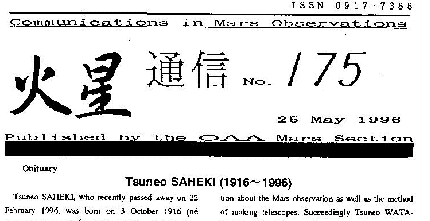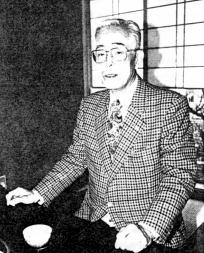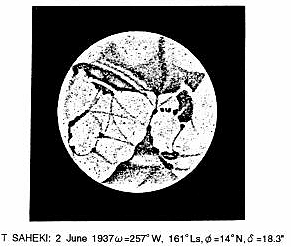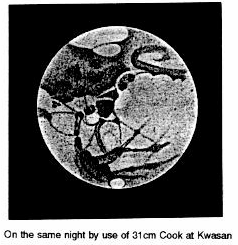CMO#175

CMO #175
25 May, 1996
- From #175 we cite two articles -
* Obituary "Tsuneo SAHEKI "
* 10 Years Ago (5) - CMO #008 (10 May 1986) and #009 (25 May 1986) - (Japanese)
Obituary
-- Tsuneo SAHEKI (1916-1996) --
 Tsuneo SAHEKI, who recently passed away on 22 February 1996, was born on 3 October 1916 (né Tsuneo WATANABÉ) at Kitsuki City of Oh-ita Prefecture in the Kyushu district. It was about in 1929 when he began to be interested in Astronomy, but at that time he did not have any telescope, and hence at the first time the stellar objects he observed were no more than the meteors, zodiacal lights and so on : At that time, he became a penpal of Minoru HONDA from Tottori Prefecture who afterwards became famous as a great comet hunter.
Tsuneo SAHEKI, who recently passed away on 22 February 1996, was born on 3 October 1916 (né Tsuneo WATANABÉ) at Kitsuki City of Oh-ita Prefecture in the Kyushu district. It was about in 1929 when he began to be interested in Astronomy, but at that time he did not have any telescope, and hence at the first time the stellar objects he observed were no more than the meteors, zodiacal lights and so on : At that time, he became a penpal of Minoru HONDA from Tottori Prefecture who afterwards became famous as a great comet hunter.
Mr. Tsuneo SAHEKI in 1985 (69 of age)
At the same time Tsuneo noticed and read several articles on Mars written by Kanamé NAKAMURA (1909-1932) of the Kwasan Observatory in a science magazine (published by the SEIBUNDO - SHINKOSHA, Tokyo), and Tsuneo wrote a letter to NAKAMURA at the Kwasan Observatory, Kyoto University. NAKAMURA's reply was fascinating to Tsuneo: NAKAMURA offered to make a mirror in favour of Tsuneo who was already a member of the OAA in 1930. Furthermore, NAKAMURA
was going to write an introductory article on the Mars observations in "The Heavens" (the Journal of the OAA, founded in 1920) since if NAKAMURA could finish the 1931 opposition, it would have meant that ten years passed ever since he had started the Mars observations. Unfortunately however both
were never realised owing to the sudden suicide of K. NAKAMURA in 1932.
Tsuneo WATANABE became around the time acquainted with Eitaro DATÉ (1912-1953) at Osaka who was gentle and to whom he owed much information about the Mars observation as well as the method of making telescopes. Succeedingly Tsuneo WATANABE obtained from another source an 8cm speculum (made by K. SAKAMAKI) and at the latest by the end of 1932 he hand-made up a reflector whose tube was made of the cardboards. He observed the Sun-spots in 1932, and from the beginning of 1933 he began to observe the planet Mars. This was an aphelic opposition so that the apparent diameter was no larger than 14 seconds of arc. Furthermore, the magnification the telescope
admitted only gave 133 × by the use of a 6mm Huygens eyepiece, and hence he could not detect any marking except for the north polar cap. Afterwards he became aware that it was mainly because he was watching the area around Mare Sirenum to Arcadia. He then tried to remove one of two lenses from the eyepiece to produce 200 ×, and later he could also borrow from a friend an Or-4mm eyepiece to have 200 ×, and accordingly in March he was excitingly able to detect such dark markings as Mare Acidalium, Sinus Sabaeus and then Syrtis Major on the reddish surface.
By that time Tsuneo also became an acquaintance of Shizuo (Haruhisa) MAYEDA (1914-1952) from Shichi-jyoh, Kyoto City who also observed Mars by the use of a 10cm spec and also possessed ANTONIADI's "La Planète Mars". DATE also showed Tsuneo the Memoirs of the BAA which contained the Section Reports,1913/14 and 1918.
The planet Mars was at opposition in 1935 on 6 April and reached the maximal apparent diameter of 15.0 arcsecs. Tsuneo WATANABE produced several nice drawings during this apparition by the use of a new 8cm spec (made by the late NAKAMURA) equipped with a new 4mm eyepiece.


The 1937 apparition was epoch-making to him as well as to other members of the Mars observers of the OAA. E.DATE constructed a 25cm reflector (mirror was made by S.KIBE). Senji Shigemaro KIBÉ (1912-1990) himself observed Mars and published already an article about the OAA 1935 Mars observations in a book. He was also very well known as an excellent mirror maker (a disciple of K. NAKAMURA). He also taught S. MAYEDA how to make specula especially 20cm F10 reflectors for the total solar eclipse in Hokkaido in 1936, and MAYEDA used one of them for the 1937 Mars. In 1937 MAYEDA obtained several colour drawings and traced the changing in hue of the canals. KIBE finally made and sent a 15cm reflector to Tsuneo WATANABE at Kyushu at the fall in 1936 for the upcoming Mars observation.
However suddenly came a post card to Tsuneo in Kyushu in February 1937 from Professor Issei YAMAMOTO (1889-1959), Director of the Kwasan Observatory and at the same time President of the OAA, who invited Tsuneo by the card of no more than two lines to come up to Kyoto and observe Mars by the use of the 31cm F15 Cook refractor of the Kwasan Observatory. On a day in April 1937 Tsuneo WATANABE was welcomed at Kyoto Station by S. KIBE who was also a member of Kwasan. From April 1937 (on 19 May at opposition) Tsuneo spent in Kwasan as an employee of the Observatory. It was good for him to be able to arbitrarily use the library of the Observatory (he extensively read the W. H. PICKERING's Reports on Mars), but the 31cm Cook did not readily allow him long to have good images because of the poor seeing condition at Kwasan. So he even wanted to go back to Kyushu. But on 2 June 1937 a wonderful night came with a good lull in the rainy season: The Martian image on the night stood still inside the eyefield of the 400-600×31cm Cook. He first noticed that S. Gomer looked more enlarged than expected. Furthermore as Syrtis Mj. rotated into the disk centre, he found a small isolated stain following the northern part of Syrtis Mj, which was later called Antigones Fons by Shiro EBISAWA (refound photographically by E. C. SLIPHER in 1939). He took three drawings on 2 June, and he also observed on 3 and 4 June under less favourable condition. These discoveries were outstanding, but in a sense somewhat determined his later attitude towards the observations of Mars. He returned home in October 1937, though his position was officially assured up until October 1939.
The next 1939 apparition was more favourable, but unfortunately already the imperialist Japan was making an invasion into the Chinese continent, and T. WATANABE was forced to serve in the army from May 1938, and stayed in China. We are not very sure about his life in 1939: According to a recent simplified T. SAHEKI's personal history compiled by Ichiro HASEGAWA in "The Heavens", Tsuneo stayed in China upto the end of 1938, but as we heard previously from himself he was in China as a member of the troops when the planet approached in 1939. At any rate he did not make any observation of Mars in 1939. E. DATE performed instead good observations that year, and Sadao MURAYAMA (1924 -) started observing Mars. Tsuneo didn't return to Kwasan and resigned his post in October 1939. (Issei YAMAMOTO had also already sent in his resignation to the Faculty of Science, Kyoto University, and retired to the Yamamoto Observatory in Shiga Prefecture, the HQ of the OAA.)
In the case of the great apparition in 1941, being now a member of the Osaka City Planetarium ever since September 1941, Tsuneo could observe the planet Mars by the use of a 25cm Cassegrain which belonged to the Planetarium. He was however not satisfied with the images of Mars which were produced by the Cassegrain (may be compared with the 31cm Cook at Kwasan), and he just watched no more than four or five times even though the apparition was the great perihelic one. MAYEDA on the other hand produced several colour drawings in 1941 (Syrtis Mj. showed a hue of cerulean blue). Mars was at opposition on 10 October 1941.
In July 1942, he was married and since then he assumed the new name Tsuneo SAHEKI. They had one boy and two girls. In 1943/44 (opposition on 5 December), Tsuneo SAHEKI could use an excellent 15cm speculum made by K. NAKAMURA. From July 1944 to August 1945, he was again in the army (Japan surrendered on no terms on 15 August 1945).
The next apparition in 1945/46 (Mars was at opposition on 14 January 1946), he was allowed to use a 46cm Calver speculum (once belonged to W. GOODACRE in England, and hence the polar axis pointed originally higher) at the Yamamoto Observatory (called Tanakami Observatory at that time) in Shiga Prefecture. At the postwar period, the transportation system was poor, and to reach the Observatory in the evening T. SAHEKI must have started Osaka early in the morning even using the local train. He walked more than six kilometres from the nearest station to the Observatory. In February he met a good seeing night when he observed the area of Elysium including N. Laocoontis. He also obtained the regression aspect of the north polar cap by the telescope from the vernal equinox to the summer solstice of the northern hemisphere. It should however be noted that his observation rate must have not been so dense because of the transportation problem. It was in winter, and at the observation intervals, Tsuneo went down to a living room to warm himself up by Kotatsu (Japanese warming system) and sometimes took a nap there, while Prof. YAMAMOTO was always studying or writing. Meantime he was asked to use MAYEDA's 20cm F10 reflector because MAYEDA, also repatriated, suffered from TB. We suppose T. SAHEKI used this in 1948 (31 of age). He was appointed as Director of the Mars Section in 1946 (continued to direct the Section until March 1990).
We are of the opinion that the Golden Age of T. SAHEKI arrived around 1950, 1952 and 1954. He was endowed at the end of 1950 or before with a very excellent 20cm F10 mirror especially polished by S. KIBE for T. SAHEKI, and by the use of it SAHEKI performed long term observations of the northern hemisphere of Mars. He also pursued the recession of the north polar cap in 1952 ranging one and half year. Several folklores were also born during the period. Since then he didn't change his telescope.
In 1952 he published a book on Mars Observation, which much inspired us. The present writer read it when he was a junior high, and wrote a letter, and he met with the great T. SAHEKI at the beginning of the 1954 apparition. This book was once revised in 1958, and in a final form in 1968. This is still a standard book (old-fashioned in many places however) on Mars Observation written in Japanese. The first revision must have been made because he wanted to compile the circumstances of the great dust storm in 1956. The last edition includes his several good observations in 1963, 1965 and 1967.
Generally speaking T.SAHEKI was more active in the aphelic apparitions: At least we are much more familiar with his observations in 1935, 1937, 1950-1954, and in 1963-1967 than those at the perihelic oppositions. This must have depended on the seeing conditions in Osaka as well as on his liking. It should however be remembered that his drawings during the great dust storm in 1956, 1971 and 1973 were also highly valuable. In 1971 he injured his dexterous hand. It was fortunate for him to have been blessed with a good health throughout his life and enjoyed a longevity compared with other contemporaries. MAYEDA died in February 1952 and DATE in August 1953. As far as we noticed he had always good posture, that is, carried himself upright. He suffered from pneumonia in 1943, and also in 1975 from a heart attack. In the latter period he injured his eyes, and became unable to observe.
He learnt by himself, but we must report that he wrote good Japanese and he was very good at the calculation of the Martian orbit and so on, and also read several foreign languages (his Observing Notes were written in English at least in the 1950s and thereafter).
Last but not the least, he was remembered by all members as a not-lazy letter writer, tried to reply every time by postcard as Director of the Section: Every observer thanks him for his kindness and his warm words. It should however be remembered that he was sometimes bitter behind his words, not always satisfied with the observations of other persons including his contemporaries.
We should further note that apart from directing the Mars Section, he served the OAA as a chief editor of the "The Heavens" from 1961. He was a Vice-President from 1959, and was President from 1990 to 1993.
He was invited to Fukui in 1994 on the occasion of the OAA General Assembly to be awarded an OAA Grand Prix, but he could not come because of an injury of his leg he suffered just before. We suppose since then he was weakened. We were suddenly informed that in the early afternoon on 22 February Tsuneo SAHEKI died by a phone call from Dr. Ichiro HASEGAWA. At the funeral on 24 February Sadao MURAYAMA represented us in expressing our deep condolences (MURAYAMA first heard of WATANABE's name in 1937, and first met him in 1947 or 1948). The May issue of "The Heavens" 77(1996) No 852 was dedicate as a mourning issue of Tsuneo SAHEKI.
Masatsugu MINAMI
10 Years Ago (5)
- CMO #008 (10 May 1986) and #009 (25 May 1986) -
火星は1986年五月には「いて座」中央部を順行中で「留」目前となっていた。当時の暦を見ると May 10 で、光度-0.9等、視直径13.4"、中央緯度 9.8゚S であり、Lsは五月中には162゚から180゚に変化して北半球の秋分間近となっていた。視直径も大きくなり南極冠も最大径の季節で見事な眺めだったようだ。火星の出も夜半前となり深夜の観測ながら各地から観測報告があった。これまでの観測者に加えて、浅田正氏(宗像)、岩崎徹氏(北九州)、日岐敏明氏(長野)、宮崎勲氏(那覇)、中島守正氏(横浜)、Tao Fan-Lin氏(台北)から五月中旬までの観測が報告されている。松本直弥氏(佐世保)からも写真が送られてきたようだが、編集には間に合わなかったとみえ次号紹介となった。
佐伯恒夫氏、浅田正氏、南政次氏の連載記事は継続している。5号で呼びかけられた「惑星写真の撮影」のアンケートには返信が次々に寄せられていて、9号からは「惑星写真の実際」として各氏の方法の自己紹介が始まった。
「OAA MARS SECTION」 は台北で南氏がまとめられていたのだが、この月になってだいぶ観測者も出そろってきて、観測報告らしい体裁が出来てきた。五月上旬には、南極冠とヘッラスとモヤとの振る舞いが観測されている(Ls=163゚-170゚)。9号には別稿で「1954年と1969年の観測から -Behaviors of Hellas in 1954 and 1969-」南政次が掲載され、この現象の以前の観測が紹介された。同様に季節が進むと起きてくる南極冠の縮小時に見られる現象が挙げられて、この後の観測の注目ポイントが示された。南氏の台北での生活の一端も半ページほど紹介されている。連日のハードなスケジュールで四月末に体調を崩されたのが記録されている。
村上昌己
Back to Top Page
Back to CMO Index
 Tsuneo SAHEKI, who recently passed away on 22 February 1996, was born on 3 October 1916 (né Tsuneo WATANABÉ) at Kitsuki City of Oh-ita Prefecture in the Kyushu district. It was about in 1929 when he began to be interested in Astronomy, but at that time he did not have any telescope, and hence at the first time the stellar objects he observed were no more than the meteors, zodiacal lights and so on : At that time, he became a penpal of Minoru HONDA from Tottori Prefecture who afterwards became famous as a great comet hunter.
Tsuneo SAHEKI, who recently passed away on 22 February 1996, was born on 3 October 1916 (né Tsuneo WATANABÉ) at Kitsuki City of Oh-ita Prefecture in the Kyushu district. It was about in 1929 when he began to be interested in Astronomy, but at that time he did not have any telescope, and hence at the first time the stellar objects he observed were no more than the meteors, zodiacal lights and so on : At that time, he became a penpal of Minoru HONDA from Tottori Prefecture who afterwards became famous as a great comet hunter.

